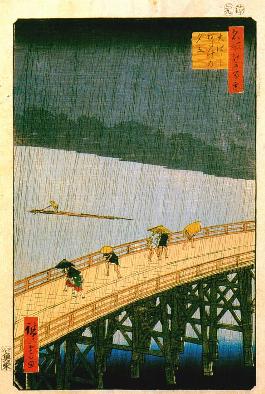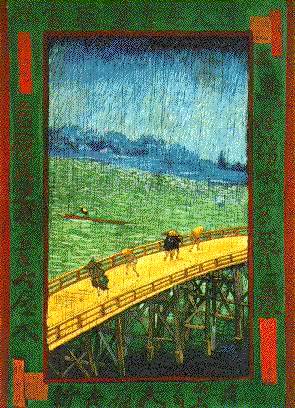黑色的歌 By Wisława Szymborska ( 辛波絲卡1923-2012)林蔚昀譯,2016
Sparrows in the Snow
日本橋雪晴
歌川広重( Utagawa Hiroshige 1797-1858) 1857,因梵谷 ( 1853-1890 ) 一八八七年的仿作,Nana ( the 1880 novel by Émile Zola. 驟雨);橋上的人們 By Wisława Szymborska (1923-2012);Suzuki Harunobu,
辛波絲卡詩選 誠品網購‧博客來網購
Wisława Szymborska (1923-2012)
陳黎‧張芬齡 譯
寶瓶文化增訂版《辛波絲卡詩集》(2011,60首)
&《最後》(2019,60首)

一個奇怪的星球,上面住著奇怪的人。
他們受制於時間,卻不願意承認。
他們自有表達抗議的獨特方式。
他們製作小圖畫,譬如像這張:
初看,無特別之處。
你看到河水。
以及河的一岸。
還有一條奮力逆航而上的小船。
還有河上的橋,以及橋上的人們。
這些人似乎正逐漸加快腳步
因為雨水開始從一朵烏雲
傾注而下。
此外,什麼事也沒發生。
雲不曾改變顏色或形狀。
雨未見增強或停歇。
小船靜止不動地前行。
橋上的人們此刻依舊奔跑
於剛才奔跑的地方。
在這關頭很難不發表一些想法:
這張畫絕非一派天真。
時間在此被攔截下來。
其法則不再有參考價值。
時間對事件發展的影響力被解除了。
時間受到忽視,受到侮辱。
因為一名叛徒,
一個歌川廣重
(一個人,順便一提,
已故多年,且死得其時),
時間失足倒下。
你儘可說這只不過是個不足道的惡作劇,
只具有兩三個星系規模的玩笑。
但是為求周全,我們
還是補上最後的短評:
數個世代以來,推崇讚譽此畫,
為其陶醉感動,
一直被視為合情合理之舉。
但有些人並不以此為滿足。
他們更進一步聽到了雨水的濺灑聲,
感覺冷冷的雨滴落在他們的頸上和背上,
他們注視著橋以及橋上的人們,
彷彿看到自己也在那兒,
參與同樣無終點的賽跑,
穿越同樣無止盡,跑不完的距離,
並且有勇氣相信
這的確如此。

譯注:此詩提到的畫為日本浮世繪畫家歌川廣重 ( Utagawa Hiroshige, 1797-1858 )一八五七年所作《名所江戶百景》中的
一幅——〈大橋安宅驟雨〉(大橋安宅の夕立),此畫因梵谷 ( 1853-1890 ) 一八八七年的仿作〈雨中的橋〉而著名。
-----
禮拜天美術神遊 (66):Nana萬象:畫像史詩、難忘的小說/電影 (14):Nana (1926 film; the 1880 novel by Émile Zola.)Valtesse de La Bigne
https://www.facebook.com/hanching.chung/videos/4506459256031513
Valtesse de La Bigne
https://en.wikipedia.org/wiki/Valtesse_de_La_Bigne
ヴァルテッセデラビッグン
At the request of Léon Hennique, she showed Émile Zola round her hôtel particulier at 98, Boulevard Malesherbes. Her bedchamber and bed were the inspiration for those in his novel Nana: "A bed such as has never existed, a throne, an altar where Paris came to admire her sovereign nudity [...]. Along its sides, a band of cupids among flowers who look on and smile, watching the pleasures in shadows of the curtains." When she read the novel, Valtesse was indignant to find such a description of her decor – "some traces of tender foolishness and gaudy splendour"[9] — and called the character of Nana (for which she was the inspiration) "a vulgar whore, stupid, rude!" Alexandre Dumas fils asked to enter her bedroom, but she coldly replied, "Dear sir, it's not within your means!"[10]

She wrote her own death announcement, stating: "One must love a little or a lot, following nature, but quickly, during an instant, as one loves a birdsong which speaks to one's soul and which one forgets with its last note, as one loves the crimson hues of the sun at the moment when it disappears below the horizon".
她寫了自己的死亡公告,說:“一個人必須愛大自然一點點或很多,但要在瞬間迅速完成,因為一個人愛鳥鳴,它在表達著一個人的靈魂,而一個人忘卻了最後一個音符,就像一個人 愛在太陽消失在地平線以下的那一刻的深紅色。”
-----


 查看該圖像
查看該圖像關注作者
Emile Zola
Nana (Oxford World's Classics) (Engli
《娜娜》
- Nana, a 1926 French film by Jean Renoir
https://www.youtube.com/watch?v=4Zm6jDSiR08
Nana 1926
Nana (1926 film)
| Nana | |
|---|---|
 | |
| Directed by | Jean Renoir |
| Produced by | Pierre Braunberger |
| Written by | Pierre Lestringuez Jean Renoir Émile Zola (novel) |
| Starring | Catherine Hessling Werner Krauss Jean Angelo |
| Music by | Maurice Jaubert |
| Cinematography | Jean Bachelet Edmund Corwin |
| Edited by | Jean Renoir |
Production company | Les Films Jean Renoir |
| Distributed by | Les Établissements Braunberger-Richebé |
Release date | 25 June 1926 |
Running time | 150 minutes |
| Country | France |
| Language | French |
Nana is a 1926 French silent drama film directed by Jean Renoir and starring Catherine Hessling, Werner Krauss and Jean Angelo. It was Renoir's second full-length film and is based on the 1880 novel by Émile Zola.
It was shot at the Bavaria Studios in Munich and the Neuilly Studios in Paris. The film's sets were designed by the art director Claude Autant-Lara.
Plot[edit]
A government official, Count Muffat, falls under the spell of Nana, a young actress. She becomes his mistress, living in the sumptuous apartment which he provides for her. Instead of elevating herself to Muffat's level, however, Nana drags the poor man down to hers - in the end, both lives have been utterly destroyed.
Production[edit]
The film stars Renoir's wife, Catherine Hessling, in an eccentric performance as the flawed heroine Nana.
Jean Renoir's film is a fairly faithful adaptation of Émile Zola's classic novel. The film's extravagances include two magnificent set pieces – a horse race and an open air ball. The film never made a profit, and the commercial failure of the film robbed Renoir of the opportunity to make such an ambitious film again for several years.
Cast[edit]
- Catherine Hessling as Nana
- Werner Krauss as Count Muffat
- Jean Angelo as Count de Vandeuvres
- Raymond Guérin-Catelain as Georges Hugon
- Pierre Lestringuez as Bordenave
- Jacqueline Forzane as La Comtesse Sabine Muffat
- Claude Autant-Lara as Fauchery
- Pierre Champagne as Hector de la Faloise
- Karl Harbacher as Francis - le coiffeur
- Valeska Gert as Zoe - la femme de chambre
- Jacqueline Ford as Rose Mignon
- Dennis Price as Le jockey de 'Nana'
- Gresham as Le jockey de 'Lusignan'
- Luc Dartagnan as Maréchal - le bookmaker
- Nita Romani as Satin
- Roberto Pla as Bosc
- Gorieux as Le médecin


沒有留言:
張貼留言